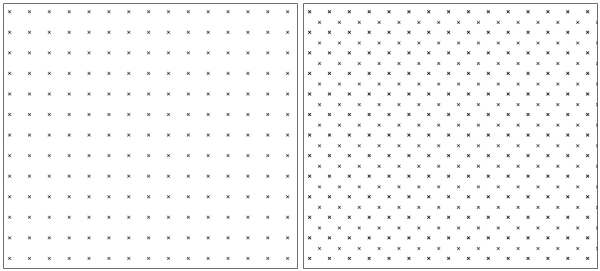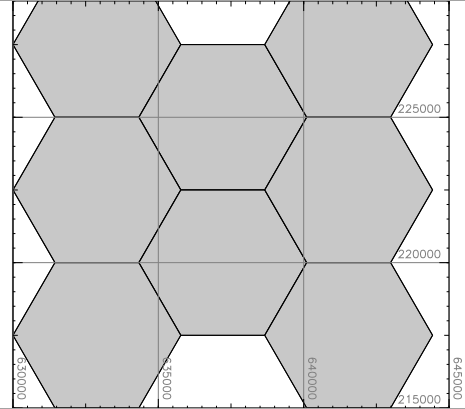
Note: A new GRASS GIS stable version has been released: GRASS GIS 7.4, available here.
Updated manual page: here
NAME
v.mkgrid - Creates a vector map of a user-defined grid.KEYWORDS
vector, geometry, grid, point patternSYNOPSIS
Flags:
- -h
- Create hexagons (default: rectangles)
- -a
- Allow asymmetric hexagons
- --overwrite
- Allow output files to overwrite existing files
- --help
- Print usage summary
- --verbose
- Verbose module output
- --quiet
- Quiet module output
- --ui
- Force launching GUI dialog
Parameters:
- map=name [required]
- Name for output vector map
- grid=rows,columns
- Number of rows and columns in grid
- position=string
- Where to place the grid
- Options: region, coor
- Default: region
- region: current region
- coor: use 'coor' and 'box' options
- coordinates=east,north
- Lower left easting and northing coordinates of map
- box=width,height
- Width and height of boxes in grid
- angle=float
- Angle of rotation (in degrees counter-clockwise)
- Default: 0
- breaks=integer
- Number of vertex points per grid cell
- Options: 0-60
- Default: 0
- type=string
- Output feature type
- Options: point, line, area
- Default: area
Table of contents
DESCRIPTION
v.mkgrid creates a vector map representation of a regular coordinate grid. Point, line, and area vector grids can be created.NOTES
Grid points created with the type=point option will be placed at the center of each grid cell, like centroids with the default type=area option.Grid lines created with the type=line option will be identical to the edges of each grid cell, like boundaries with the default type=area option.
The resultant grid can be rotated around the origin (center of the grid) with the angle option.
Optionally hexagons can be created with the -h flag. Hexagons are by default symmetric. Asymmetric hexagons can be allowed with the -a flag.
This module is NOT to be used to generate a vector map of USGS quadrangles, because USGS quads are not exact rectangles.
EXAMPLES
Creating a global grid in a latitude-longitude
To be run in a latitude-longitude location (WGS84)# set the region: g.region n=90 s=-90 w=-180 e=180 res=10 -p projection: 3 (Latitude-Longitude) zone: 0 datum: wgs84 ellipsoid: wgs84 north: 90N south: 90S west: 180W east: 180E nsres: 10 ewres: 10 rows: 18 cols: 36 cells: 648 # create 10 degree size grid: v.mkgrid map=grid_10deg # create 20 degree size grid: v.mkgrid map=grid_20deg box=20,20
Creating a grid in a metric projection
Creating a 4x3 grid, cells 20km a side, with lower left corner at 2716500,6447000:v.mkgrid map=coro_grid grid=4,3 position=coor coordinates=2716500,6447000 box=20000,20000
Creating a positioned grid in a latitude-longitude
Creating a 10x12 lat/lon grid, cells 2 arc-min a side, with lower left corner at 167deg 52min east, 47deg 6min south. For use with e.g. QGIS you can then pull this grid into a projected location with v.proj before exporting as a Shapefile with v.out.ogr (within GRASS GIS you could just use d.grid -w from the projected location for the same effect):v.mkgrid map=p2min_grid grid=10,12 position=coor coordinates=167:52E,47:06S box=0:02,0:02
Creating a simple point pattern
North Carolina sample dataset example, creating a 1km spaced point grid based on the current region extent defined by the "elevation" map:g.region raster=elevation res=1000 -pa v.mkgrid type=point map=pointpattern
Creating a regular point pattern
North Carolina sample dataset example, creating a regular spaced point grid based on the current region extent defined by the "elevation" map, using a two-step approach:# create first set of points, covering extent of "elevation" raster map g.region raster=elevation res=1000 -pa v.mkgrid type=point map=pointpattern1 # shift grid by half point distance (map units) g.region n=n+500 w=w+500 e=e+500 s=s+500 -p # create second set of points v.mkgrid type=point map=pointpattern2 # merge into final point pattern v.patch input=pointpattern1,pointpattern2 output=pointpattern3

Different point patterns for sampling design
Creating hexagons in a metric projection
North Carolina sample dataset example, creating regular hexagons based on the current region extent defined by the "elevation" map and raster resolution for the hexagon size:g.region raster=elevation res=5000 -pa v.mkgrid map=hexagons -h d.grid 5000

Hexagon map
SEE ALSO
d.grid, v.in.region, v.patchAUTHORS
Michael Higgins, U.S.Army Construction Engineering Research LaboratoryUpdate for new vectors Radim Blazek 10/2004
Last changed: $Date: 2014-12-27 15:21:19 -0800 (Sat, 27 Dec 2014) $
SOURCE CODE
Available at: v.mkgrid source code (history)
Note: A new GRASS GIS stable version has been released: GRASS GIS 7.4, available here.
Updated manual page: here
Main index | Vector index | Topics index | Keywords index | Full index
© 2003-2018 GRASS Development Team, GRASS GIS 7.0.7svn Reference Manual